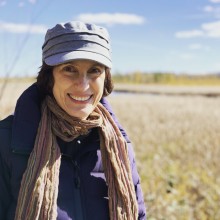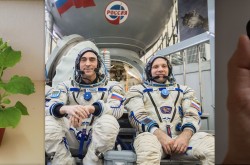My face blind life

Let me begin with a few snippets from my life (and yes, these really happened!).
1. I’m talking to my tall, slim, ponytailed waiter, when I notice four more of him in the restaurant. They look like clones.
Strange! Am I in some weird Netflix show? (If I am, it is an awfully long episode.) Why, just this week I found out that the friendly strawberry blonde woman at work is not one person but two. No wonder our ongoing conversations get confusing! Too bad it took me seven months to figure out that’s because I was talking to two different people.
2. I make it to the end of Fargo Season 3 without knowing that actor Ewan McGregor plays two characters.
This is no surprise to my family, who are used to me asking: “Is this the same blonde or a different one?” “Do we know this character?” “Who died?” “Who killed them?”
If you’ve tried to watch History Channel’s Vikings and felt like every character looked the same, you feel my pain. That’s what it is like every time I walk into the lunchroom at work.
3. I fly to visit an old friend overseas but arrive and realize that I have no idea what she looks like, other than that she is Japanese. And this is Japan.
Fear grips me as I realize that if I cannot find her, I’ll have no place to stay and no one to ask for help. Even worse, I have my young daughter with me. My heart beating out of my chest, I panic for 45 minutes waiting. Thankfully, my friend finds me.
I should not be surprised that this has happened. Taken out of context, I can’t recognize my own father. Sadly, he’s just another friendly, bespectacled bald guy in golf attire.
4. On the first day of a new job, I keep waiting for my boss to arrive. Turns out she’s one of the “coworkers” I have been chatting with for 45 minutes. (Crap! What have I said?)
She had straight hair and glasses when she interviewed me, but today has an explosion of curls and no eyewear. So to me, she’s now a complete stranger.
5. While sitting in a restaurant in Santa Fe, New Mexico, I think: Wow, that crabby-looking woman over there is wearing the same exact vintage Etro paisley shirt as me; what are the odds? But she should really do something about her hair.
It’s not until 15 minutes later that I finally figure out the restaurant has a mirrored wall, and the woman is me. Now I know that I cannot even recognize my own face. And also, I really should smile more.
What’s WRONG with me?!
As you may have guessed from these glimpses into my life, I am face blind.
It’s ok if you’re thinking, “Well, that sounds fake!” Plenty of people smile, laugh, or even scoff when I tell them. Hey, I get it. If this were a fictional plot, I’d call it too farfetched. But prosopagnosia — the scientific name for face blindness — is a very real thing and it is a non-visible disability.
There are degrees of face blindness, and it is possible to be “a bit face blind,” or “really bad with faces.” My case is extreme, so I’ve participated in prosopagnosia studies run by Dartmouth College professor Dr. Brad Duchaine, the co-founder of faceblind.org. His team at Dartmouth work in collaboration with Harvard University and the University of London. When tested, I could not recognize my spouse’s face when it was put onto Putin’s head (to put this into context, my spouse is Asian).
I am far from the only person afflicted. In fact, Dr. Duchaine has estimated that as many as one in 50 people are affected by prosopagnosia to some degree. Actor Brad Pitt told Esquire that he has such a hard time remembering the faces of those he meets, he thinks he might suffer from face blindness. The list of famous people who have been officially diagnosed with prosopagnosia includes anthropologist Jane Goodall, British actor Stephen Fry, Apple co-founder Steve Wozniak, and Victoria, Crown Princess of Sweden. So, at least I’m in good company.

The highlighted area indicates the fusiform gyrus of the human brain. Generated based on the Desikan-Killiany atlas using BrainPainter software.
But…why?!?
So, what’s the science behind this face blindness thing?
Our brains have some areas that are specialized for processing certain kinds of visual input. One of those areas, located in the fusiform gyrus, just loves faces! It responds to faces more than any other kind of stimulus, and seems to help us identify faces and process them holistically. The problem isn’t visual or cognitive. When a person without face blindness sees a face, they don’t see a nose, a mouth, two eyes, etc. Instead, they see those features bound together into a unique face.
People with face blindess, like me, don’t show this specialization in the face region of the brain. Recognizing someone by their face is as hard for us as recognizing people by their elbow would be for you. Since we can’t bind facial features into a whole unique face, we prosopagnosics rely on individual distinctive features or markers to identify people. (For NON-faceblind people, I’m including a cool little experiment for you to try at the end of this article!)
Gimme eight seconds…I (might) get this!
For non-face blind people, it takes an estimated one second to recognize someone. For face blind people like me, it takes at least eight seconds until we have a guesstimate.
Here are my top markers:
Voice
This is the best trick in my arsenal. However, it only works if I know a person well enough. I need time to get to know you and really memorize your sound, and I need you to speak to me. Just saying, “Hi!” frankly isn’t much to go on, so I may be waiting to hear more.
One Halloween, my neighbour’s sister had the most elaborate costume imaginable — a costume and body paint which turned her into a Mayan pyramid! She was thunderstruck because over 200 people had failed to recognize her, but I knew her by voice.
Hair
Specifically, I need to be able to see your hairline, shades of hair colour, and curls if any (thank goodness our President and CEO, Christina Tessier, has a distinctive curl pattern! Without it, I would never be able to greet her by name). Got a hat on? You’re a stranger to me now (even if you are my brother!). Pulled your hair into a ponytail? Forget about it, it’s hopeless; I have no chance of recognizing you.
I don’t seem to be able to “see” facial hair as a marker, though some face blind people do (the only reason I know that you grew a beard — or shaved one off — is because of your Facebook post that told me so). To clarify, I can see that beard on your face the way I can see your other individual features. I can judge beauty, so if I tell you that beard looks good, I do mean it. What I can’t do is recall any sense of your face when not looking at it, and I can’t “see” it when I look at your whole face as you approach me in a new encounter. It only comes into view if I try really hard to focus on each individual feature.
Context
A tall, bald golfer with an extra short woman who has blonde curls? Could be any couple. But if they are at my family picnic, the context tells me, “Hey Ally, these must be your folks!”
Accessories
The fact that you love a certain colour. That religious necklace you always wear. Your fondness for butterfly hairclips. Your wedding and engagement ring. These are the clues I use to confirm your identify.
Physicality
Body size, gait, and posture are less reliable, so they are more of a backup plan. Lots of people are average-sized. You don’t look tall or short when you’re seated. People don’t always slouch.
However, it does help if you have an extreme feature — a very rugged jawline, or an uber-petite nose. It needs to be drastically different from “normal” proportions for me to be able to perceive it. Think Jay Leno or Brian Mulroney, now those are some chins I can work with (but please don’t ask me to tell Jay and Brian apart…I cannot)!
Every time I see you, I’m desperately scanning for clues to cross-reference. If I’m lucky, eight seconds later I have a reasonable guess. If I don’t? Forgive me if I just smile and say, “Hey, you!”
Go further
Looking for more science on face blindness? Here’s something cool to try if you are NON-faceblind.
The Face Inversion Effect: Evidence that non-face blind people process faces holistically! The Fusiform Face Area (FFA) can't bind features together when a face is upside down, because this is unnatural. For example, take this photo of the singer Adele. To a non-faceblind person, this seems fine, just a normal photo flipped upside down.

...But if you flip the image right-side up, we suddenly realize that it's actually horrifying. This is also called the "Thatcher Illusion," a particular example of the Face Inversion Effect.

References about prosopagnosia
• A review paper about brain imaging studies on the Fusiform Face Area
• A short accessible blog post about the research
• fMRI study about prosopagnosics and the Fusiform Face Area (This study shows that even though people who have prosopagnosia do not have clear brain damage to the Fusiform Face Area (FFA), the patterns of brain activity only seem to represent individual facial features instead of holistic faces.)
• An article from Business Insider about the flipped Adele image going viral on social media









